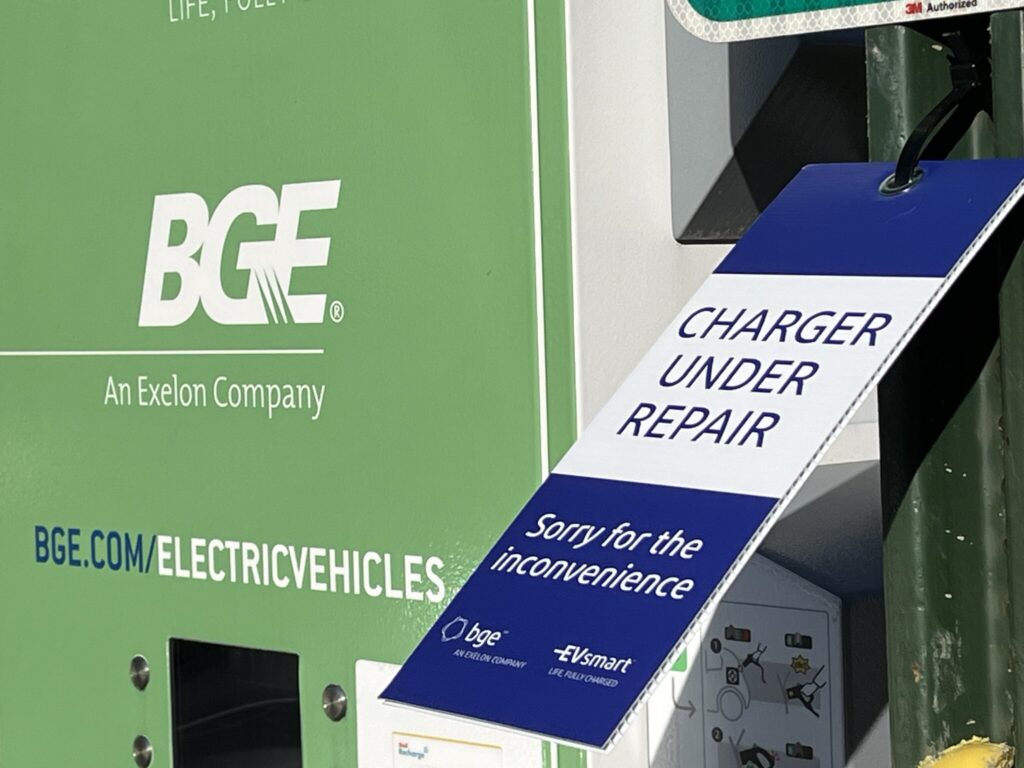A survey by private group of electric vehidle enthusiasts found recently that charger reliabilty was a mixed bag, from 99.6% operable ports at Tesla charging staions to just 33% for BGE stations, and 31% for Delmarva Power. (Photo by Lanny Hartmann)
In 2023, Gov. Wes Moore joined Maryland to California’s Advanced Clean Cars II program, pledging to slash greenhouse gas emissions by phasing out gasoline vehicle sales by 2035. Barely two years later, he signed an executive order delaying penalties for these Zero-Emission Vehicle Goals, blaming insufficient charging infrastructure.
The real culprit? A large portion of Maryland’s public chargers are utility-owned and routinely broken — mocking the drivers who rely on them and the ratepayers who funded them.
Since 2019, the Maryland Public Service Commission has let utilities like BGE, Pepco, Delmarva Power, Potomac Edison and SMECO operate public EV chargers in a pilot program now nearing its end. BGE alone spent $15 million installing chargers at libraries, parks and government buildings.
The utilities vowed these stations would match the reliability of their electric grid. Instead, they’ve delivered a charging disaster. Now, they want four more years — and more ratepayer cash — to keep it limping along.
Your opinion matters
Maryland Matters welcomes guest commentary submissions at editor@marylandmatters.org.
We suggest a 750-word limit and reserve the right to edit or reject submissions. We do not accept columns that are endorsements of candidates, and no longer accept submissions from elected officials or political candidates.
Opinion pieces must be signed by at least one individual using their real name. We do not accept columns signed by an organization. Commentary writers must include a short bio and a photo for their bylines.
Views of writers are their own.
The utilities’ pitch in 2018 was simple: Give us millions, and we’ll build a dependable electric vehicle network. But drivers know the truth: These chargers are often down. Worse, utilities outsourced most operations to third-party contractors. When a charger fails, EV drivers don’t call BGE for a quick fix — they’re stuck dialing a “network provider,” where complaints vanish into a virtual black hole, sometimes taking months to resolve. This isn’t service; it’s abandonment.
In 2023, the General Assembly demanded accountability, passing House Bill 834, the Electric Vehicle Charging Reliability Act, requiring 97% uptime, backed by quarterly reports and penalties for failure. Two years on, the Public Service Commission has yet to see those reports. Drivers, meanwhile, feel reliability worsening.
Moore’s executive order, citing the very infrastructure utilities failed to deliver, only deepens the distrust — easing pressure on automakers instead of fixing the public charging networks.
Fed up, I joined 12 other Maryland EV drivers to survey every fast charger statewide. Our Maryland Fast Charger Survey visited 304 locations, testing over 1,000 ports.
Tesla, running more than half of Maryland’s fast chargers, delivered 99.6% availability — 541 of 543 ports worked. BGE? A measly 33% (30 of 90 chargers operational). Delmarva Power’s Eastern Shore network was the worst at 31% (4 of 13). These aren’t chargers; They’re proof utilities can’t deliver.
Now, utilities propose bigger budgets for a second phase of the pilot program, funneling more money to contractors for obsolete chargers. Unlike Tesla’s stations—built near 24-hour stores with 8 to 16 plugs pumping up to 325 kW—most utility chargers are stuck at 50 kW, often with just one or two ports. They’re not at vibrant hubs but in desolate corners of parking lots, like behind state office buildings.
Why pour millions into slow, outdated chargers nobody wants to use?
Moore’s order admits the infrastructure isn’t ready, but after six years, that’s no excuse — it’s a failure of leadership. Utilities have had time and money to build a network that works. Instead, they’ve squandered trust and dollars.
The Public Service Commission must end this failed experiment, redirect funds to proven models like supporting commercial charger programs, and demand Moore recommit to Zero-Emission Vehicle Goals with infrastructure that delivers. Marylanders deserve better than broken chargers and weak promises. It’s time to pull the plug.
Read the full article here


